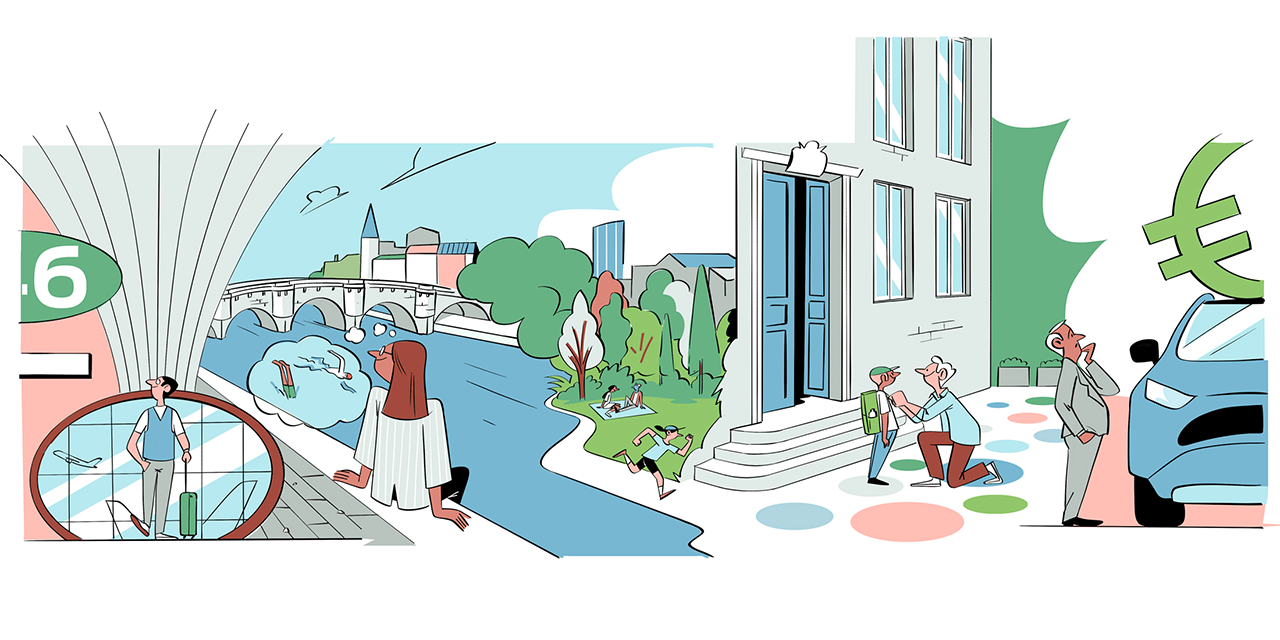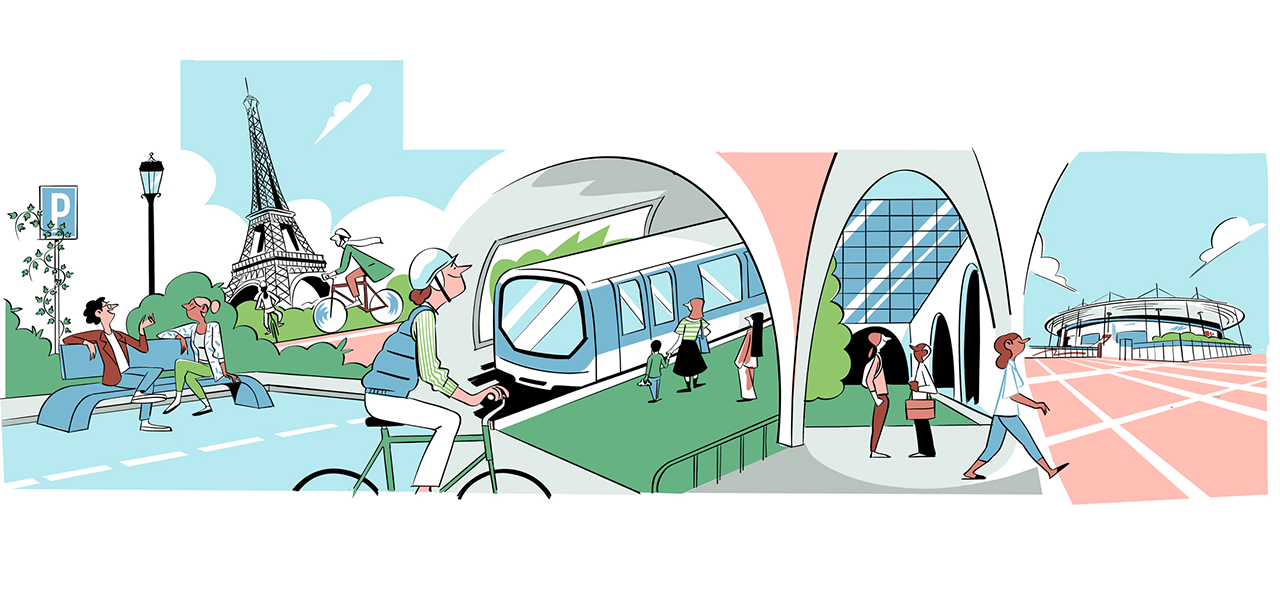Affairs: Paris 2024 / Paris
Ready for action
The French capital has done much to clean, tidy and tighten itself up ahead of the opening ceremony.
Despite their brevity, the Olympic Games cast a long shadow. For every successful 21st-century iteration – Sydney 2000, London 2012 – there have been Games that have seemed to confirm all negative stereotypes, not just about the host city but the country it is in (Athens 2004, Tokyo 2020, we’re looking at you). It is perhaps because of the relatively short duration that critics are always so concerned with the legacy of each Olympics, even though governments spend more on things that last a much shorter time and are far less entertaining.
Paris 2024 arrives at a combustible juncture. A fractious geopolitical landscape is not exactly conducive to carefree enjoyment, while inflation and climate change potentially make the decision to spend a vast amount of public money on unnecessary construction a vexed issue. It is a sign of the times that its organisers have sought to make the lack of new buildings a defining feature of this year’s Games. The main action will take place at the Stade de France, which was built for the 1998 football World Cup. Other landmarks such as the Eiffel Tower, the river Seine and the Place de la Concorde will provide dramatic backdrops to other events.
Anne Hidalgo, Paris’s mayor, has been criticised for her confrontational politics but she has seized the opportunity provided by the Olympics with admirable zeal. Much of her efforts have been directed towards the goal of making Paris “the greenest big city in Europe” and, while that is hyperbolic, Hidalgo has enacted policies that have already made the city cleaner, greener and more pleasant without the usual attendant hubristic grand projects. Not all of the following urban fixes are the mayor’s own but together they represent an inspiring collection of policies that other cities, especially those hosting future Olympic Games, would do well to emulate.
1
travel
First stop
Checked luggage
The job of being a good host begins as soon as your guests arrive. Paris’s main airport, Charles de Gaulle, has unveiled a new baggage-handling set-up to cope with the Olympian influx of spectators, athletes and members of the media. The airport’s baggage handlers are expected to process more than 114,000 items of luggage from national delegations and members of the press, with an additional 47,000 pieces of sporting equipment from the athletes themselves. To assist them in this bicep-busting endeavour, the airport has constructed a 10,000 sq m “baggage factory”, a bespoke luggage-processing zone, which should ensure that travellers receive their possessions in record time. The airport has also taken delivery of a new scanner system that will provide a more detailed look at passengers’ luggage – and should mean they don’t need to remove electronics and liquids from their bags before security.
2
infrastructure
Cleaning up the Seine
Water sports
The awarding of the Olympics and Paralympics to Paris galvanised the city’s authorities into moving forward with a long-discussed plan baignade (“bathing plan”), dedicated to cleaning up the polluted river Seine in order to make it swimmable. As with most things in life, this was easier said than done. In the end, the €1.4bn scheme – which involved disinfecting wastewater discharges near treatment plants, eliminating the direct discharge of wastewater into the river from boats and treating sources of pollution upstream of Paris – looks set to deliver a clean Seine in time for it to host the Games’ opening ceremony: a flotilla of boats on the river in the centre of the city. It will also provide the setting for the triathlon and marathon-swimming contests. Taking a dip in the capital’s river was outlawed in 1923 due to safety concerns; 101 years later, Parisians will be able to bathe in it once again. When the Games are over, that is.
3
environment
Urban forestry
Seeds of change
The motto for Paris 2024 is Ouvrons Grand les Jeux (“Games wide open”) but it could just as easily have been “soil wide open”. As part of its bid to become the greenest capital city in Europe, Paris has embarked on a gargantuan tree-planting programme, including 8,876 in and around the Olympic Village, part of a larger plan to put 170,000 in the ground by 2026. A large portion of this effort has been focused on cultivating several urban forests that will feel welcoming to the wider community. This has resulted in small city sites metamorphosing from neglected, cold spaces to ones in which biodiversity thrives. One such setting is Place de Catalogne, a large roundabout near the Gare Montparnasse, which is now home to an urban forest of 478 trees. There is also a much more ambitious, though not yet confirmed, idea to turn the Champs-Élysées into a pedestrian-friendly “extraordinary garden”. Watch this space.

4
urbanism
School-friendly streets
Paved with gold
Hundreds of rues aux écoles (“school streets”) have been created since 2020. These roads outside nurseries and primary schools have been pedestrianised and had their traffic furniture replaced with trees and planters. Where possible, removable barriers have been installed, making these spaces flexible for parents and children to gather and play in. The programme is not only meant to deliver safer public spaces around schools but also to tackle pollution and help create islands of fresh air in the heart of the urban environment. More school streets are expected by the end of this year. Paris is a relatively small city, at least its older centre, so getting around by foot or bicycle need not be an impossibility. Many Parisians have already ditched their cars (car use in the city has fallen consistently since 2012 and in 2020 it fell in the Greater Paris region for the first time) and these school streets aim to nudge that down even further.
5
transport
Au revoir, les SUV
Traffic jam
Mayor Anne Hidalgo has been putting further pressure on drivers by increasing parking costs, phasing out diesel vehicles and creating no-traffic zones. But perhaps no move has been as well-publicised as the tripling of parking charges for suvs. Officials claim that the number of suvs in the city has increased by 60 per cent since 2020, meaning that they now make up 15 per cent of the private vehicles in Paris. Following a referendum earlier this year, the city has decreed a special parking rate for “heavy and polluting” vehicles. The cost of on-street parking for such cars is now set at €18 an hour in the centre and €12 in the rest of the city, with exemptions for taxi drivers, delivery vehicles, health workers, people with disabilities and residents. The aim is not only to reduce the environmental impact that suvs have but also to discourage people from driving into the city when coming from the suburbs or further afield.
6
transport
Park it
Getaway, cars
As part of her re-election campaign in 2020, Anne Hidalgo pledged to remove almost half of Paris’s 140,000 on-street car-parking spaces by the end of her second term in 2026, with a focus on those in narrow and residential streets. Many attribute this pledge to Hidalgo’s advisor, Carlos Moreno, a Franco-Colombian academic known for his contributions to the 15-minute city concept. All over Paris, former spaces have been filled with planters, trees and other street furniture. Priority for those spaces that remain will be given to locals and businesses. As these green spaces become more established, there is a plan to diversify them – proposals include installing vegetable allotments, food-composting areas, playgrounds and eco-toilets. Much of this is happening in areas that are limited to traffic for the Games (only permit-holders can drive through), though the mayor hopes that these low-traffic areas will become permanent after the Olympics have left town.

7
transport
Take a bike
Easy rides
Paris has seen unprecedented investment in and expansion of its bike lanes. The plan is to eventually increase their total length (the city already has more than 1,000km cycle lane) in time for the Games. These new routes (dubbed “Olympilanes”) have been built to link the main venues, which have also seen the addition of some 10,000 new bike racks. At the same time, there has also been an expansion of the famous Velib bike-hire scheme, which, when it was launched in 2007, was one of the world’s first citywide programmes. City Hall has added 3,000 units to its inventory in an attempt to encourage Games attendees to cycle to events. For those who prefer to travel on two legs rather than two wheels, a long-distance hiking trail built in the Auteuil district in support of Paris’s 2024 Olympic bid has been a big hit, proving that long urban walks need not go near busy roads.
8
transport
Upgrading Le Métro
Track record
The Régie autonome des transports parisiens (ratp), the body that operates Paris’s public transport system, has had a busy 2024. In February it began replacing its old Siemens automatic control software with a new system to increase capacity during peak periods. Whereas the old system could handle 35 trains at once, with an interval of 105 seconds between them, the new one will be able to handle 65 at a time with an interval of 80 seconds. But perhaps the centrepiece of ratp’s Olympian transformation is the extension of the m14 Métro line. It will be lengthened by 1.5km to the north, terminating at the new Saint-Denis Pleyel station, and by 14km to the south, where it will connect with Orly Airport, linking the Olympic Village to three major train stations (Saint-Lazare, Gare de Lyon and Bercy) as well as the Stade de France and the new Aquatics Centre. Seven new stations will be opening across the line.
9
architecture
Inner-city redevelopment
Designs for life
In 2014, Anne Hidalgo launched Réinventer Paris, a design competition looking for proposals for redeveloping 23 inner-city sites. Of the winners, Morland Mixité Capitale, designed by David Chipperfield Architects Berlin with Parisian practice brs and Calq, is perhaps the most eye-catching. An imposing former administrative building on the banks of the Seine in the 4th arrondissement has been converted into a “lively campus”, featuring a panoply of public and retail spaces. There is a combination of high-end and subsidised housing, youth hostel, offices, a food market, kindergarten, nightclub and a luxury hotel and restaurant. The pièce de résistance is the top two floors, which feature a bar, restaurant and roof garden (with cutting-edge phyto-purification system). This space is open free-of-charge to the public who can enjoy stunning views over the city.
10
stadia
Gold-standard centrepiece
The main event
The piece of infrastructure that will likely come to symbolise the Games this summer is something that was there all along. The Stade de France, the country’s 80,000-capacity national stadium, which was built for the 1998 Fifa World Cup, has been adapted to be the main event stadium for the Games. Six new bars have been added, while lighting and electronics have been fully modernised – two new high-definition screens have been positioned in the north and south stands to replay footage. French phone operator Orange has also installed a number of large 5G transmitters in the roof. But the most dazzling addition is the stadium’s new 14,000 sq m purple running track. Traditionalists might balk at its radical hue but at least the Games’ organisers won’t be derided for going against another Olympic tradition: building an expensive new stadium that becomes a white elephant as soon as the event leaves town.


